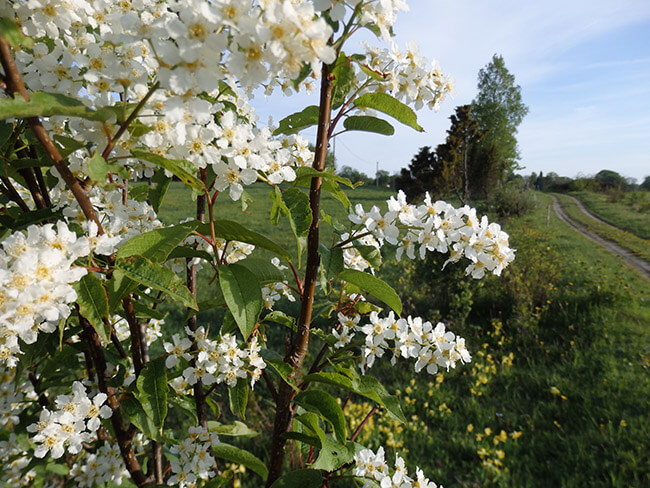
The first of the much anticipated, life-affirming and life-altering spring floral trinity to appear in Eesti is the toomingas aka toome/puu. A very revered, much sung and written about shrub to tree (8-16 m tall), it is a species of wild cherry, native to northern Europe and n.Asia, south of the Arctic Circle. Its English names are bird cherry, hackberry and Mayday tree (Prunus padus) and although it’s sold as an ornamental plant in North America, it’s not the star it is in Europe. I never knew what all the fuss was about, or even what it was when I was still living in Toronto. Photo: Riina Kindlam
Sections of Estonian woods are currently a patchwork of light green and white – the white being the flowering toomingas. Currently easy to spot, after they have flowered they become quite incognito amongst the rohelus (greenery). When in doubt, snap a twig – if it smells pungent, it’s a toomingas. Its fragrant blossoms are also overwhelming, even headache-causing in concentrated quantities. Best not to bring them indoors.
I would venture to say, that the top 3 most loved and admired kevade/kuulutajad (harbingers of spring) in Estonian nature are the: 1) toomingas, blossoming white; 2) õunapuu – apple tree, blossoming white and pinkish and 3) sirel – lilac, blossoming purple and white. You must remember that our landscape has been barren and relatively lifeless for almost 7 months, which is just as long as a lot of other places in the northern hemisphere, but somehow… harsher, darker, colder, longer, as anyone who has been here during that time can attest to.
So when these classic begin to bloom – and one reason they are classics is because the nature in Eesti is not all that varied – everyone notices and I dare say most are in awe. Shock is perhaps a better word. The sudden explosion of light, warmth and growth are initially overwhelming. Its been so long, can this be real?! Estonians are masters of doubt. And for a reason.
Õunapuud (apple trees) have forever been in everyone’s yards in the city and country. They were key to survival. And also have an amazing affinity in rural areas for wandering and “turning wild” (metsistuma). And sirelid (lilacs), especially vanad (old) sirelid, with curvy trunks, hanging heavy over picket fences or marking spots where farms used to stand – are symbolic of our great-grandmothers and beyond, young love, graduations, confirmations and so much more – waiting. They are full of bittersweet longing (igatsus). My Vanamamma had lilacs in her yard near High Park in Toronto and I somehow intrinsically knew it was a direct emotional link to Eesti. Spring’s greatest lesson is to cherich, because the õrnad õied (delicate blooms) are so fleeting.
In honor of the season, I’m happy to say I know local young women in their late teens named Sirel and Lill, I’m sure the names Mai, Urve, Meiu, Lehti, Taimi and Õie will have their comeback hour (fear not the Õ!) and Ieva is Latvian for toomingas, the glorious bird cherry.
Riina Kindlam,
Tallinn















